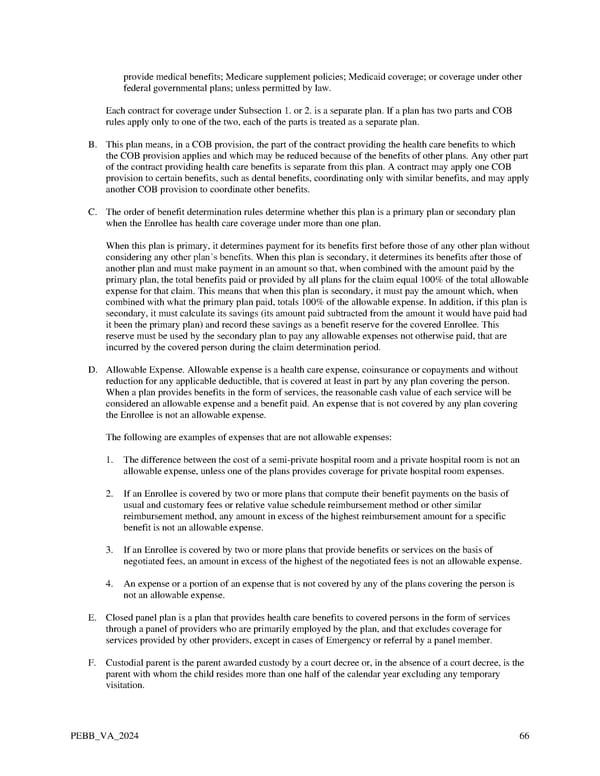provide medical benefits; Medicare supplement policies; Medicaid coverage; or coverage under other federal governmental plans; unless permitted by law. Each contract for coverage under Subsection 1. or 2. is a separate plan. If a plan has two parts and COB rules apply only to one of the two, each of the parts is treated as a separate plan. B. This plan means, in a COB provision, the part of the contract providing the health care benefits to which the COB provision applies and which may be reduced because of the benefits of other plans. Any other part of the contract providing health care benefits is separate from this plan. A contract may apply one COB provision to certain benefits, such as dental benefits, coordinating only with similar benefits, and may apply another COB provision to coordinate other benefits. C. The order of benefit determination rules determine whether this plan is a primary plan or secondary plan when the Enrollee has health care coverage under more than one plan. When this plan is primary, it determines payment for its benefits first before those of any other plan without considering any other plan’s benefits. When this plan is secondary, it determines its benefits after those of another plan and must make payment in an amount so that, when combined with the amount paid by the primary plan, the total benefits paid or provided by all plans for the claim equal 100% of the total allowable expense for that claim. This means that when this plan is secondary, it must pay the amount which, when combined with what the primary plan paid, totals 100% of the allowable expense. In addition, if this plan is secondary, it must calculate its savings (its amount paid subtracted from the amount it would have paid had it been the primary plan) and record these savings as a benefit reserve for the covered Enrollee. This reserve must be used by the secondary plan to pay any allowable expenses not otherwise paid, that are incurred by the covered person during the claim determination period. D. Allowable Expense. Allowable expense is a health care expense, coinsurance or copayments and without reduction for any applicable deductible, that is covered at least in part by any plan covering the person. When a plan provides benefits in the form of services, the reasonable cash value of each service will be considered an allowable expense and a benefit paid. An expense that is not covered by any plan covering the Enrollee is not an allowable expense. The following are examples of expenses that are not allowable expenses: 1. The difference between the cost of a semi-private hospital room and a private hospital room is not an allowable expense, unless one of the plans provides coverage for private hospital room expenses. 2. If an Enrollee is covered by two or more plans that compute their benefit payments on the basis of usual and customary fees or relative value schedule reimbursement method or other similar reimbursement method, any amount in excess of the highest reimbursement amount for a specific benefit is not an allowable expense. 3. If an Enrollee is covered by two or more plans that provide benefits or services on the basis of negotiated fees, an amount in excess of the highest of the negotiated fees is not an allowable expense. 4. An expense or a portion of an expense that is not covered by any of the plans covering the person is not an allowable expense. E. Closed panel plan is a plan that provides health care benefits to covered persons in the form of services through a panel of providers who are primarily employed by the plan, and that excludes coverage for services provided by other providers, except in cases of Emergency or referral by a panel member. F. Custodial parent is the parent awarded custody by a court decree or, in the absence of a court decree, is the parent with whom the child resides more than one half of the calendar year excluding any temporary visitation. PEBB_VA_2024 66
 Kaiser Permanente WA Value EOC (2024) Page 65 Page 67
Kaiser Permanente WA Value EOC (2024) Page 65 Page 67